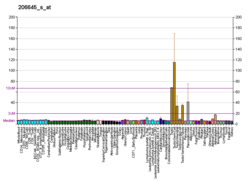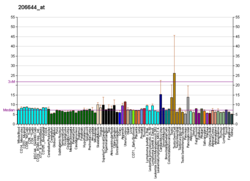DAX1 (dosage-sensitive sex reversal, adrenal hypoplasia critical region, on chromosome X, gene 1) is a nuclear receptor protein that in humans is encoded by the NR0B1 gene (nuclear receptor subfamily 0, group B, member 1). The NR0B1 gene is located on the short (p) arm of the X chromosome between bands Xp21.3 and Xp21.2, from base pair 30,082,120 to base pair 30,087,136.
Function
This gene encodes a protein that lacks the normal DNA-binding domain contained in other nuclear receptors. The encoded protein acts as a dominant-negative regulator of transcription of other nuclear receptors including steroidogenic factor 1. This protein also functions as an anti-testis gene by acting antagonistically to SRY. Mutations in this gene result in both X-linked congenital adrenal hypoplasia and hypogonadotropic hypogonadism.
DAX1 plays an important role in the normal development of several hormone-producing tissues. These tissues include the adrenal glands above each kidney, the pituitary gland and hypothalamus, which are located in the brain, and the reproductive structures (the testes and ovaries). DAX1 controls the activity of certain genes in the cells that form these tissues during embryonic development. Proteins that control the activity of other genes are known as transcription factors. DAX1 also plays a role in regulating hormone production in these tissues after they have been formed.
Role in disease
X-linked adrenal hypoplasia congenita is caused by mutations in the NR0B1 gene. More than 90 NR0B1 mutations that cause X-linked adrenal hypoplasia congenita have been identified. Many of these mutations delete all or part of the NR0B1 gene, preventing the production of DAX1 protein. Some mutations cause the production of an abnormally short protein. Other mutations cause a change in one of the building blocks (amino acids) of DAX1. These mutations are thought to result in a misshapen, nonfunctional protein. Loss of DAX1 function leads to adrenal insufficiency and hypogonadotropic hypogonadism, which are the main characteristics of this disorder.
Duplication of genetic material on the X chromosome in the region that contains the NR0B1 gene can cause a condition called dosage-sensitive sex reversal. The extra copy of the NR0B1 gene prevents the formation of male reproductive tissues. People who have this duplication usually appear to be female, but are genetically male with both an X and a Y chromosome.
In some cases, genetic material is deleted from the X chromosome in a region that contains several genes, including NR0B1. This deletion results in a condition called adrenal hypoplasia congenita with complex glycerol kinase deficiency. In addition to the signs and symptoms of adrenal hypoplasia congenita, individuals with this condition may have elevated levels of lipids in their blood and urine and may have problems regulating blood sugar levels. In rare cases, the amount of genetic material deleted is even more extensive and affected individuals also have Duchenne muscular dystrophy.
Interactions
DAX1 has been shown to interact with:
- COPS2,
- NRIP1,
- Steroidogenic factor 1, and
- SREBF1.
References
- ^ GRCh38: Ensembl release 89: ENSG00000169297 – Ensembl, May 2017
- ^ GRCm38: Ensembl release 89: ENSMUSG00000025056 – Ensembl, May 2017
- "Human PubMed Reference:". National Center for Biotechnology Information, U.S. National Library of Medicine.
- "Mouse PubMed Reference:". National Center for Biotechnology Information, U.S. National Library of Medicine.
- ^ "Entrez Gene: NR0B1 nuclear receptor subfamily 0, group B, member 1".
- Walker AP, Chelly J, Love DR, Brush YI, Récan D, Chaussain JL, Oley CA, Connor JM, Yates J, Price DA (Nov 1992). "A YAC contig in Xp21 containing the adrenal hypoplasia congenita and glycerol kinase deficiency genes" (PDF). Human Molecular Genetics. 1 (8): 579–85. doi:10.1093/hmg/1.8.579. PMID 1301166.
- Goodfellow PN, Camerino G (Jun 1999). "DAX-1, an 'antitestis' gene". Cellular and Molecular Life Sciences. 55 (6–7): 857–63. doi:10.1007/PL00013201. PMC 11147076. PMID 10412368. S2CID 19764423.
- McCabe ER (Feb 2007). "DAX1: Increasing complexity in the roles of this novel nuclear receptor". Molecular and Cellular Endocrinology. 265–266: 179–82. doi:10.1016/j.mce.2006.12.017. PMC 1847396. PMID 17210221.
- Iyer AK, McCabe ER (2004). "Molecular mechanisms of DAX1 action". Molecular Genetics and Metabolism. 83 (1–2): 60–73. doi:10.1016/j.ymgme.2004.07.018. PMID 15464421.
- Tab. 1.1 of Stefan White & Andrew Sinclair: The Molecular Basis of Gonadal Development and Disorders of Sex Development, in: John M. Hutson, Garry L. Warne, & Sonia R. Grover (eds): Disorders of Sex Development. An Integrated Approach to Management, Springer 2012, ISBN 978-3-642-22963-3, e-ISBN 978-3-642-22964-0, DOI: 10.1007/978-3-642-22964-0.
- Altincicek B, Tenbaum SP, Dressel U, Thormeyer D, Renkawitz R, Baniahmad A (Mar 2000). "Interaction of the corepressor Alien with DAX-1 is abrogated by mutations of DAX-1 involved in adrenal hypoplasia congenita". The Journal of Biological Chemistry. 275 (11): 7662–7. doi:10.1074/jbc.275.11.7662. PMID 10713076.
- ^ Sugawara T, Abe S, Sakuragi N, Fujimoto Y, Nomura E, Fujieda K, Saito M, Fujimoto S (Aug 2001). "RIP 140 modulates transcription of the steroidogenic acute regulatory protein gene through interactions with both SF-1 and DAX-1". Endocrinology. 142 (8): 3570–7. doi:10.1210/endo.142.8.8309. PMID 11459805.
- ^ Lopez D, Shea-Eaton W, Sanchez MD, McLean MP (Dec 2001). "DAX-1 represses the high-density lipoprotein receptor through interaction with positive regulators sterol regulatory element-binding protein-1a and steroidogenic factor-1". Endocrinology. 142 (12): 5097–106. doi:10.1210/endo.142.12.8523. PMID 11713202.
Further reading
- Achermann JC, Meeks JJ, Jameson JL (Dec 2001). "Phenotypic spectrum of mutations in DAX-1 and SF-1". Molecular and Cellular Endocrinology. 185 (1–2): 17–25. doi:10.1016/S0303-7207(01)00619-0. PMID 11738790. S2CID 20651430.
- Franzese A, Brunetti-Pierri N, Spagnuolo MI, Spadaro R, Giugliano M, Mukai T, Valerio G (May 2005). "Inappropriate tall stature and renal ectopy in a male patient with X-linked congenital adrenal hypoplasia due to a novel missense mutation in the DAX-1 gene". American Journal of Medical Genetics Part A. 135 (1): 72–4. doi:10.1002/ajmg.a.30670. PMID 15800903. S2CID 39583218.
- Achermann JC (Jun 2005). "The role of SF1/DAX1 in adrenal and reproductive function". Annales d'Endocrinologie. 66 (3): 233–9. doi:10.1016/s0003-4266(05)81755-x. PMID 15988384.
- Niakan KK, McCabe ER (2006). "DAX1 origin, function, and novel role". Molecular Genetics and Metabolism. 86 (1–2): 70–83. doi:10.1016/j.ymgme.2005.07.019. PMID 16146703.
- Worley KC, Towbin JA, Zhu XM, Barker DF, Ballabio A, Chamberlain J, Biesecker LG, Blethen SL, Brosnan P, Fox JE (Aug 1992). "Identification of new markers in Xp21 between DXS28 (C7) and DMD" (PDF). Genomics. 13 (4): 957–61. doi:10.1016/0888-7543(92)90007-F. hdl:2027.42/29935. PMID 1505987.
- Petersen KE, Bille T, Jacobsen BB, Iversen T (Nov 1982). "X-linked congenital adrenal hypoplasia. A study of five generations of a Greenlandic Family". Acta Paediatrica Scandinavica. 71 (6): 947–51. doi:10.1111/j.1651-2227.1982.tb09554.x. PMID 6891556. S2CID 43416274.
- Burris TP, Guo W, Le T, McCabe ER (Sep 1995). "Identification of a putative steroidogenic factor-1 response element in the DAX-1 promoter". Biochemical and Biophysical Research Communications. 214 (2): 576–81. doi:10.1006/bbrc.1995.2324. PMID 7677767.
- Bardoni B, Zanaria E, Guioli S, Floridia G, Worley KC, Tonini G, Ferrante E, Chiumello G, McCabe ER, Fraccaro M (Aug 1994). "A dosage sensitive locus at chromosome Xp21 is involved in male to female sex reversal". Nature Genetics. 7 (4): 497–501. doi:10.1038/ng0894-497. PMID 7951319. S2CID 20673267.
- Zanaria E, Muscatelli F, Bardoni B, Strom TM, Guioli S, Guo W, Lalli E, Moser C, Walker AP, McCabe ER (Dec 1994). "An unusual member of the nuclear hormone receptor superfamily responsible for X-linked adrenal hypoplasia congenita". Nature. 372 (6507): 635–41. Bibcode:1994Natur.372..635Z. doi:10.1038/372635a0. PMID 7990953. S2CID 4363344.
- Muscatelli F, Strom TM, Walker AP, Zanaria E, Récan D, Meindl A, Bardoni B, Guioli S, Zehetner G, Rabl W (Dec 1994). "Mutations in the DAX-1 gene give rise to both X-linked adrenal hypoplasia congenita and hypogonadotropic hypogonadism". Nature. 372 (6507): 672–6. Bibcode:1994Natur.372..672M. doi:10.1038/372672a0. PMID 7990958. S2CID 4314671.
- Guo W, Burris TP, McCabe ER (Oct 1995). "Expression of DAX-1, the gene responsible for X-linked adrenal hypoplasia congenita and hypogonadotropic hypogonadism, in the hypothalamic-pituitary-adrenal/gonadal axis". Biochemical and Molecular Medicine. 56 (1): 8–13. doi:10.1006/bmme.1995.1049. PMID 8593542.
- Yanase T, Takayanagi R, Oba K, Nishi Y, Ohe K, Nawata H (Feb 1996). "New mutations of DAX-1 genes in two Japanese patients with X-linked congenital adrenal hypoplasia and hypogonadotropic hypogonadism". The Journal of Clinical Endocrinology and Metabolism. 81 (2): 530–5. doi:10.1210/jcem.81.2.8636263. PMID 8636263.
- Guo W, Burris TP, Zhang YH, Huang BL, Mason J, Copeland KC, Kupfer SR, Pagon RA, McCabe ER (Jul 1996). "Genomic sequence of the DAX1 gene: an orphan nuclear receptor responsible for X-linked adrenal hypoplasia congenita and hypogonadotropic hypogonadism". The Journal of Clinical Endocrinology and Metabolism. 81 (7): 2481–6. doi:10.1210/jcem.81.7.8675564. PMID 8675564.
- Nakae J, Tajima T, Kusuda S, Kohda N, Okabe T, Shinohara N, Kato M, Murashita M, Mukai T, Imanaka K, Fujieda K (Oct 1996). "Truncation at the C-terminus of the DAX-1 protein impairs its biological actions in patients with X-linked adrenal hypoplasia congenita". The Journal of Clinical Endocrinology and Metabolism. 81 (10): 3680–5. doi:10.1210/jcem.81.10.8855822. PMID 8855822.
- Schwartz M, Blichfeldt S, Müller J (Jan 1997). "X-linked adrenal hypoplasia in a large Greenlandic family. Detection of a missense mutation (N4401) in the DAX-1 gene; implication for genetic counselling and carrier diagnosis". Human Genetics. 99 (1): 83–7. doi:10.1007/s004390050316. PMID 9003500. S2CID 31266597.
- Takahashi T, Shoji Y, Shoji Y, Haraguchi N, Takahashi I, Takada G (Mar 1997). "Active hypothalamic-pituitary-gonadal axis in an infant with X-linked adrenal hypoplasia congenita". The Journal of Pediatrics. 130 (3): 485–8. doi:10.1016/S0022-3476(97)70217-8. PMID 9063431.
- Nakae J, Abe S, Tajima T, Shinohara N, Murashita M, Igarashi Y, Kusuda S, Suzuki J, Fujieda K (Nov 1997). "Three novel mutations and a de novo deletion mutation of the DAX-1 gene in patients with X-linked adrenal hypoplasia congenita". The Journal of Clinical Endocrinology and Metabolism. 82 (11): 3835–41. doi:10.1210/jcem.82.11.4342. PMID 9360549.
- Zazopoulos E, Lalli E, Stocco DM, Sassone-Corsi P (Nov 1997). "DNA binding and transcriptional repression by DAX-1 blocks steroidogenesis". Nature. 390 (6657): 311–5. Bibcode:1997Natur.390..311Z. doi:10.1038/36899. PMID 9384387. S2CID 4417467.
External links
- GeneReviews/NCBI/NIH/UW entry on 46,XY Disorder of Sex Development and 46,XY Complete Gonadal Dysgenesis
- OMIM entries on 46,XY Disorder of Sex Development and 46,XY Complete Gonadal Dysgenesis
- GeneReviews/NIH/NCBI/UW entry on X-Linked Adrenal Hypoplasia Congenita including Complex Glycerol Kinase Deficiency
- GeneCard for NR0B1
| Transcription factors and intracellular receptors | |||||||||||||||||||||||||||||||
|---|---|---|---|---|---|---|---|---|---|---|---|---|---|---|---|---|---|---|---|---|---|---|---|---|---|---|---|---|---|---|---|
| |||||||||||||||||||||||||||||||
| |||||||||||||||||||||||||||||||
| |||||||||||||||||||||||||||||||
| |||||||||||||||||||||||||||||||
| |||||||||||||||||||||||||||||||
| see also transcription factor/coregulator deficiencies | |||||||||||||||||||||||||||||||






